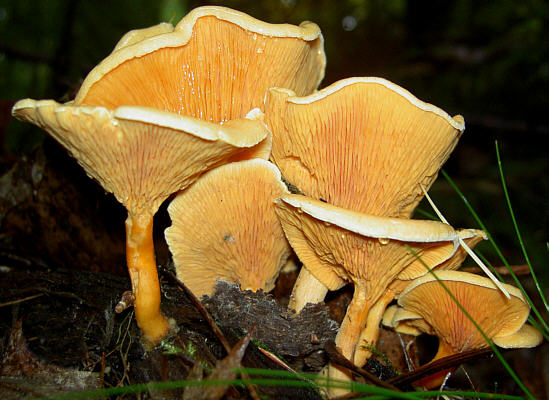Alright, so let’s just get right back into our discussion about
those lovely little orange forest dwellers.
Today I would like to talk about what to do once you have
yourself a little basket full. Chanterelles are great mushrooms because they
are usually free of maggots and store very well. I have left chanterelles in my
fridge for up to two weeks and they have still been great to use. If you want to keep them longer then that is
also possible, although not in your fridge.
Let’s start off with what to do as soon as you get back.
With a bit of luck while you were out gathering you had the foresight to carry
a little brush with you and cleaned each mushroom before popping it into your
basket. This is the best way to clean them if they are relatively dry when you
are harvesting. If you brush them off well and cut, rather then pull, then your
mushrooms are basically ready to eat as soon as you get home.
(
The black stringy things are licorice fern root, we will
touch on those in another post)
If you're more of an impulsive mushroom hunter who runs manic
in the forest snatching up little orange caps and squirreling them, covered in
debris, into bags or backpacks you will have a little more work to do. I really
would recommend the brush and basket method, I have spent many a long nights
washing or brushing dirty broken mushrooms into an edible state, occasionally giving
up and deciding that pine nettles really don’t taste that bad.
If you have made the mistake of bringing home dirty
mushrooms you can either brush or wash them.
Brushing will keep them dry and firm but will not get all
the dirt off, which, once cooked, isn’t really an issue.
Washing them will get them very clean but chanterelles tend
to suck up water like a sponge and if you try to cook them after this you will
be disappointed to find mushroom mush instead of cute little mushroom slices.
I have a friend who swears by washing and them leaving out overnight,
with a towel underneath, to dry up. Don’t leave them longer then a
night out however or they may start to rot. Once they have sat out for a while
(a few hours to overnight will work) place them in a paper bag in the fridge. They
will slowly dry out this way over several days.
 |
| Photo courtesy of Tash |
If you would like to use your soggy mushrooms right away
(this method also works if you have gathered your mushrooms in the rain) I
would recommend dry sautéing them before using them in whatever recipe.
Dry sautéing is something almost anyone who has a basic idea
of the workings of a stove can accomplish. Simply cut your mushrooms into
slices and throw in a pan on high heat with no oil. Stir the mushrooms occasionally
and you will find they quickly release all the stored up water, filling the pan
with a lovely mushroom stock (which you can collect and use in soup). Drain the pan as it fills with water, keeping
the water if you wish to use it and place the mushrooms back on the stove. They
are done when they are no longer releasing water. Usually I find they are done
after I drain water the first time.
You can see the liquid released by the mushrooms in this
photo.
Here is the liquid
c
ollected from dry sautéing, I like to keep it to use as a
mushroom stock in soups.
Once you have dry sautéed chanterelles you can freeze them
for use later or use them in any recipe, including soups and they will keep
their form. I always dry sauté my mushrooms before cooking with them even if
they seem quite dry. If you find they are releasing no water then you can take
them off the stove and use however you like. The dry sauté and freeze method is how I
usually store my chanterelles.
I also freeze young dry firm chanterelles(pictured above). If they are firm
and dry enough they will hold their form when defrosting and can be cut up and
used as normal whatever time of year you get to them. I have heard of drying
and canning chanterelles but I have not experimented with this myself so can
only recommend the dry sautéing and freezing or just freezing method.
These two methods are certainly the easiest quickest methods
to preserving your autumn harvest in a form that can be easily used later on. To
use simply defrost and toss them in whatever recipe you desire, chopping them
up if they have been frozen whole and raw.
So that covers the basics of my methods of preparing and
storing mushrooms. Next time we will start getting into what to do with these tasty
caps you have so lovingly collected, prepared and stored.
Until then, happy hunting!
- Katy
























